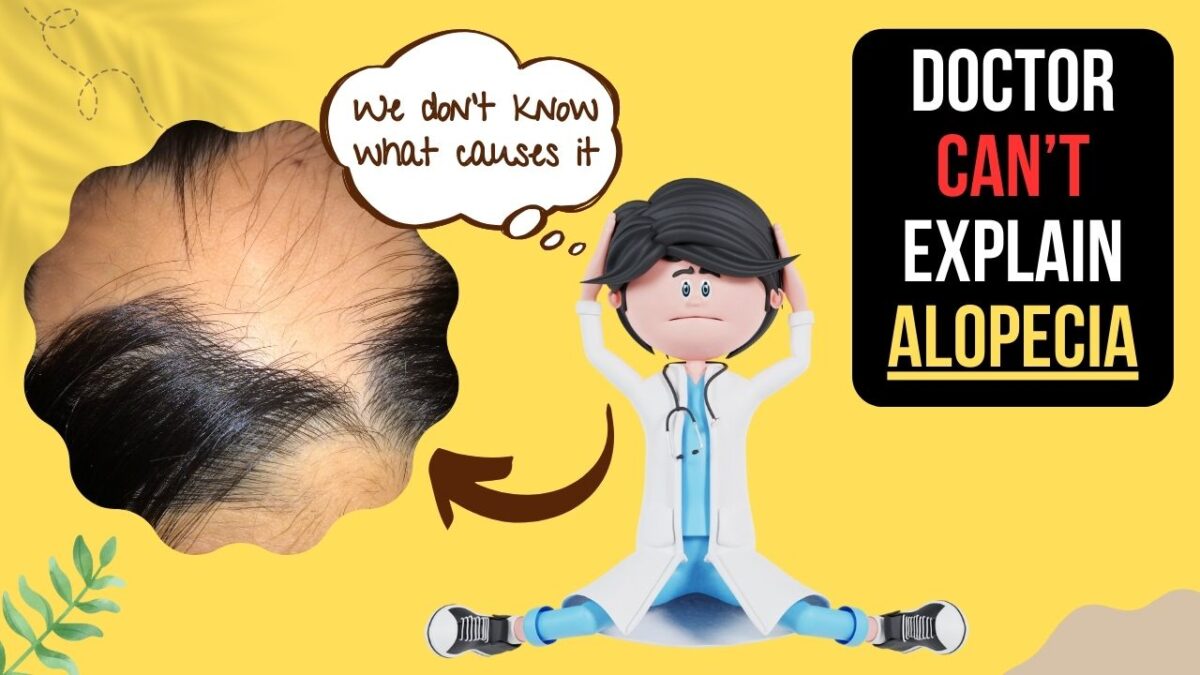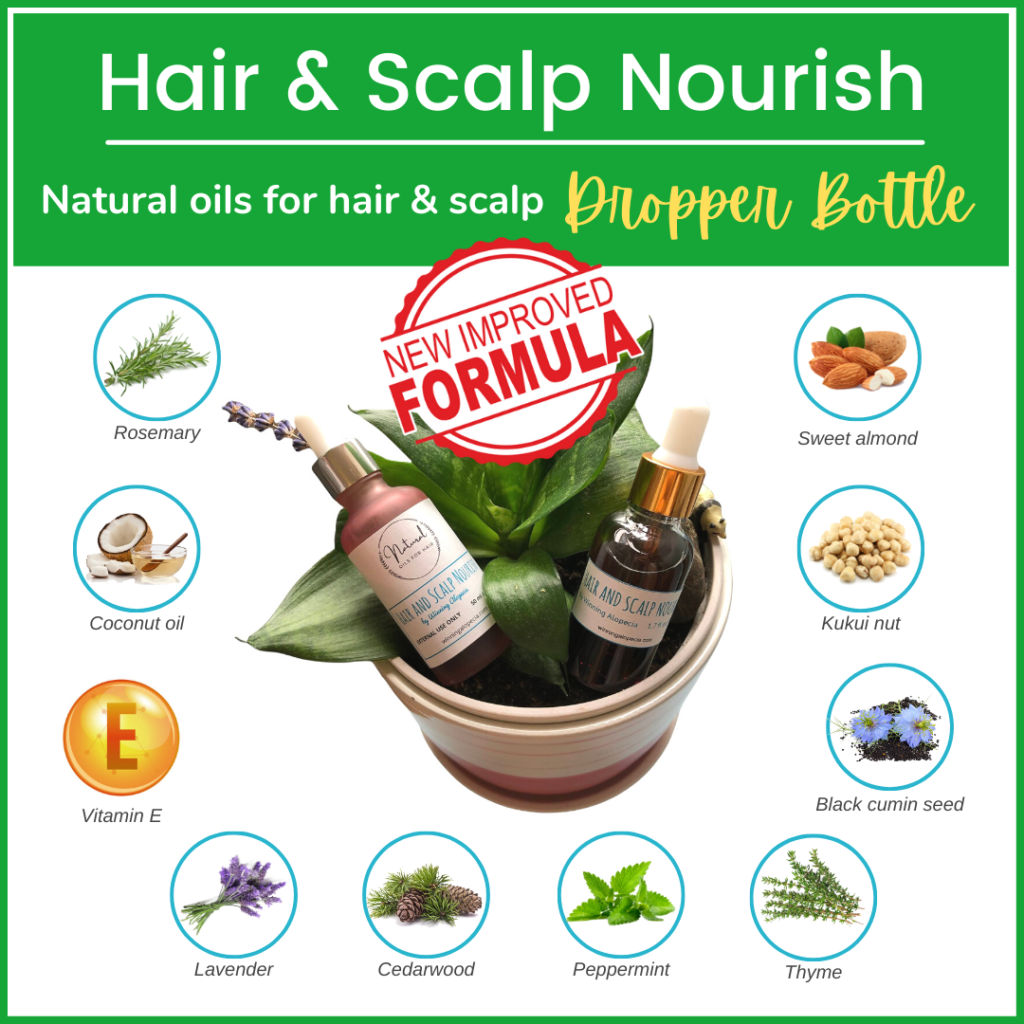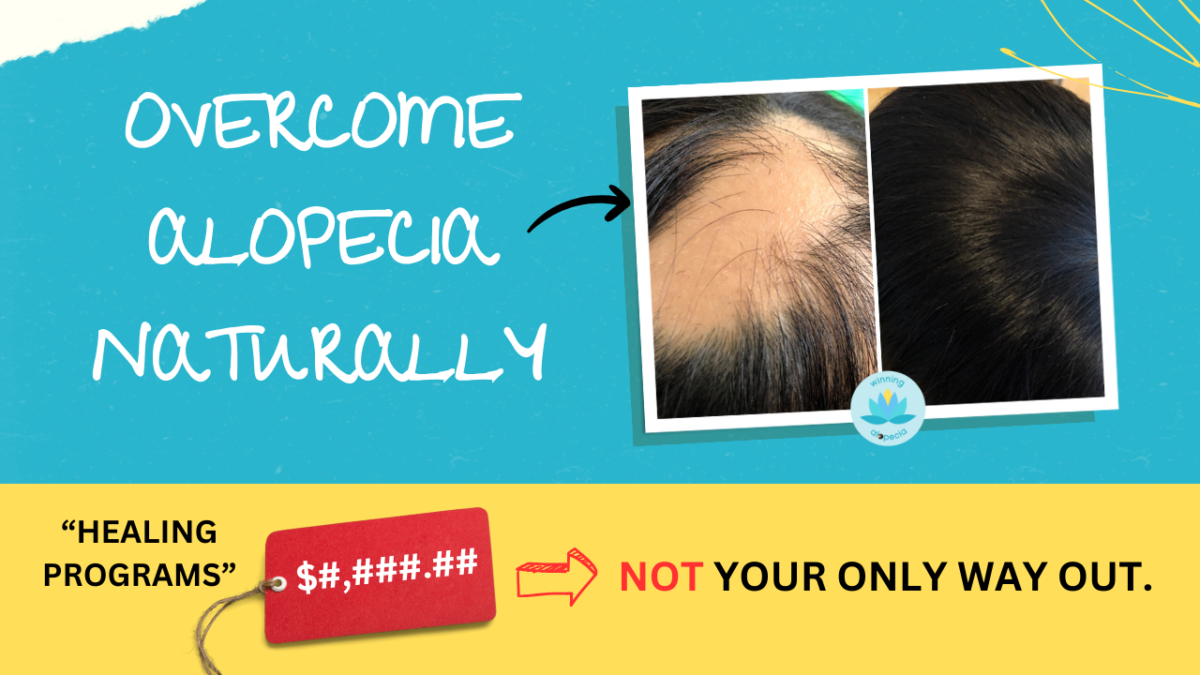What is Alopecia? What are the signs and symptoms of Alopecia? What causes hair loss due to Alopecia? And the most important questions… What can we do about it? Will your hair ever grow back from Alopecia?
I’m going to talk about all these from first-hand experience — not just theories — and YES, the causes ARE KNOWN, and I’m gonna talk about those too. Plus… How can we get our hair back using ways that your doctors don’t talk about?
Okay so, first off, what is alopecia?
Alopecia is basically just a general medical term that means hair loss, or absence of hair where it would normally be expected to grow on parts of the body. Alopecia itself comes in different types of forms, depending on the causes and the patterns of hair loss. The type of alopecia I’ll be talking about in this video and in my channel in general is autoimmune Alopecia, which is caused by a multitude of factors completely unrelated to the hair itself, but they affect the overall functioning and balance of our immune system and they result in hair loss as the visible symptom.
Now, there are a few types of Alopecia which are non-autoimmune related, such as:
Androgenetic Alopecia, more widely known as male pattern baldness or female pattern baldness. This is a hereditary type of hair loss condition where the hair loss is gradual and it occurs in a predictable pattern.
Traction Alopecia, where the hair loss is caused by excessive physical tension on the hair, such as from certain tight hairstyles or the use of certain hair accessories that cause stress on the hair shafts.
Trichotillomania, which is hair loss that is caused by repetitive pulling of the hair. This is usually due to a psychological disorder.
Telogen Effluvium, where hair follicles prematurely enter the resting phase or the telogen phase of the hair growth cycle. This can be caused by things like stress, illnesses, nutritional deficiencies, hormonal changes, rapid weight loss, or as side effects of medication.
Anagen Effluvium, where external factors like toxic chemical exposure ,scalp infections or trauma on the scalp, as well as things like chemo drugs and radiation therapy, disrupt or damage the dividing hair cells in the hair follicles during the anagen phase or the active growth phase of the hair follicles.
Autoimmune Alopecia includes Alopecia Areata, Alopecia Totalis, and Alopecia Universalis.
Alopecia Areata is when the hair loss appears in patches or bald spots on the scalp.
Alopecia Totalis is total hair loss on the scalp.
Alopecia Universalis is total hair loss on the scalp and all the other parts of the body, including eyelashes, eyebrows, and other body hair.
Sometimes, autoimmune Alopecia can also appear in an ophiasis pattern, where the hair loss occurs around the sides and the back of the scalp… so, along the areas above and behind the ears and along the sides of the scalp.
These are all types of autoimmune alopecia that I’ll be talking about in this post.
What are the signs of autoimmune Alopecia?
How can you tell if it’s an autoimmune type of Alopecia? It’s important to know the difference, because Alopecia or hair loss is generally categorized by the causes, and by knowing the causes then you will know what to do about it.
Unlike other types of hair loss, a telltale sign of autoimmune Alopecia is what we call exclamation hair or broken hair. These are short stubs of hair on the area of active hair loss or the area of bald spots, and we call it exclamation point hair or exclamation mark hair because the hair gets thinner as it goes closer to the scalp, resembling exclamation mark.
Sometimes, broken hair can appear as black dots, which mean that the hair has been broken near the scalp.
If you are new to Alopecia, you most likely won’t notice these until a bald spot has formed on the scalp. By the time you notice, there are probably one or even more visible patches of hair loss already on the scalp, but before they become patches of bald spots, there would have been what we call broken hair or exclamation point hair that indicates that hair is broken near the scalp. Because it’s very hard to see or notice broken hair, it’s often missed until the hair loss has formed a patch.
A lot of information out there on the signs of autoimmune Alopecia basically just says, you know, the signs and symptoms are just patchy hair loss. But by the time you see patches of hair loss, you’ve already missed valuable opportunities to do something to stop the hair loss from progressing into more patches, into bigger patches, or even to total hair loss.
A better sign of identifying autoimmune Alopecia, in my opinion, is not bald spots, but signs of broken hair.
Now, let’s say you see broken hair or you see the bald spots and you are taking steps to control the inflammation and you notice that there is no more broken hair or no more black dots in the areas of hair loss or anywhere on your scalp, that is good news because it means that whatever you’re doing, your body agrees with. It’s “working” for you, so take note of it.
You should also see new hair sprouting in these areas of hair loss. Usually, new regrowth comes in like baby hair so they’re soft, fuzzy (like peach fuzz), and they’re often white in color at first. They should get pigmented and get longer as they grow. This is what we call new growth and this is really, really good sign.
But if you’re not seeing regrowth within a reasonably short amount of time, or the regrowth seems slow, or it seems to be taking quite a long time for the white baby hair to get pigmented into your natural hair color, that means there are other issues that you need to address, and that’s topic for another day because that can be quite a lot that we can go down a rabbit hole to try and identify what the culprits are… something is not optimized within the body that’s preventing growth.
What causes autoimmune Alopecia?
How many of you have been to your doctors with Alopecia and you are told that the cause is unknown?
If you have patchy or total alopecia and your doctor says that it’s because of stress, they don’t know what they’re talking about, because stress does not directly cause autoimmune Alopecia. Instead, stress affects the balance of your immune system, and given the right combination of factors, it can manifest into Alopecia, but autoimmune Alopecia is more than just stress.
If your child has patchy hair loss or total hair loss and your doctor said that they could have been pulling at their hair, they don’t know what they’re talking about. Hair loss that is caused by pulling of the hair or physical tension or physical stress on the hair is not autoimmune type of Alopecia, and it looks very different from autoimmune type (patchy or total hair loss).
As I said earlier in the post, in the case of autoimmune Alopecia, the cause can be multiple, underlying factors and it’s usually a combination of factors, so it’s not just one thing. But they’re not caused by anything wrong with the hair or the hair follicles itself.
To understand what causes autoimmune Alopecia, we need to understand what causes autoimmune.
The cause of autoimmune usually involves multiple underlying, often hidden and difficult-to-identify causes.
Genetic predisposition.
The number one factor in getting autoimmune Alopecia is genetic predisposition to getting autoimmunity. To me, this is a huge factor. I disagree that genetics only play a small part and that epigenetics — which are all the things that you can sort of control through your diet and lifestyle choices — are what put you on the autoimmune map. I don’t agree with that. I think that genetics give us a huge disadvantage to start with, so that we have to be really careful with epigenetics. Maybe for a lot of people get autoimmune symptoms after having made poor lifestyle choices over a period of time, but that doesn’t apply in our case.
So, the genes that you are born with give you the vulnerability to getting an autoimmune disorder, and there’s nothing you can do about your genes. You will not be the only one in your family with autoimmunity, regardless of whether they’re getting symptoms or not. They may be in the beginning stage of the autoimmune spectrum and don’t know about it, or they may have been diagnosed with autoimmune disease. Even if they do have a diagnosed autoimmune disease, it’s very likely that they don’t have Alopecia, and that it’s another type of autoimmune that affects other parts of the body.
Autoimmune symptoms are very wide-ranging, anything from infertility, unexplained miscarriages, stroke, heart disease, rheumatoid arthritis, multiple sclerosis, Crohn’s disease, Hashimoto’s disease, irritable bowel syndrome or IBS… all of these are different types and symptoms of autoimmunity.
But autoimmunity is not purely a genetic condition, so genes alone usually won’t trigger symptoms. There are two other groups of factors — yes, groups of factors — which make this extra difficult to pinpoint.
Environmental or external triggers.
So, other than genetics, environmental triggers or external triggers can include a myriad of things that contribute to the manifestation of your autoimmune genetics into a full-blown condition, in this case Alopecia.
This is anything from what you eat, even if it’s otherwise healthy, which can be the culprit that triggers your symptoms, thanks to your autoimmune genetics.
It can be what you are exposed to in your environment, so what you use on yourself, what’s in your home, in your school, in your office, your garden, personal care products, the water you drink and whether it has contaminants that happen to set things off in your system, the cookware you use and whether it contains toxic chemicals that your body doesn’t agree with, the products you use in your household — your cleaning products, laundry detergents — volatile organic compounds or VOCs in your home, whether there is mold exposure.
It can be work and life stress. It can be medications that are used BEFORE the onset of symptoms, such as medications that Wipe uut the microbial diversity in your gut and medications that stimulate your immune system.
It can be any possible stressors including stored trauma keeping you in fight or flight. It can be underlying infection or overgrowth, and not only infection that is clearly making you sick like a viral or bacterial infection, but infections like H pylori for example, or any other infection — whether it’s yeast, bacterial or fungal. It can be heavy metal toxicity, mycotoxins in your system. It can be mineral imbalance or even other autoimmune conditions.
The suspects are endless, and this is why you are often told that the cause is unknown. It’s not so much unknown… it’s just very very difficult to find out.
I’m not saying that any of these potential culprits is healthy for us, but for someone with autoimmune genetic predisposition, they can trigger an active autoimmune disease. You should be your own detective to find out what your triggers are, because if you don’t then you will not get out of that autoimmune cycle.
Intestinal permeability (leaky gut).
The other factor is intestinal permeability, or you’ve probably heard of it as leaky gut. It is thought that leaky gut precedes in all cases of autoimmunity, which means that there is always a leaky gut condition before the onset of an autoimmune condition.
Intestinal permeability or leaky gut is a condition where the tight junctions — the seals between our cells — in the gut lining is compromised. This gut lining is a critical barrier that protects us from harmful substances while allowing the entry of beneficial nutrients. But this lining is only as thin as one cell and when its Integrity is compromised, molecules that leak from this lining into your bloodstream can create problems. Your immune system sees these molecules as danger to your body and in order to protect you, it reacts by making high levels of antibodies to fight them.
The way our food systems are these days, and with the level of pollution that’s in our environment and food systems, I’d argue that everyone has leaky gut conditions. But with autoimmune genetic predisposition in your back pocket, coupled with an environmental trigger plus a leaky gut condition, you’ve got the perfect recipe for a full-blown autoimmune to manifest into symptoms. For others, leaky gut could spiral into other illnesses or health conditions down the road.
Leaky gut itself can be caused by a myriad of factors. Are you seeing how this can be an exhausting game of search and find? lol…
What you can do about autoimmune Alopecia (How to stop hair loss and get your hair back)
So what can we do about autoimmune Alopecia? Can your hair grow back?
Current medical treatment for Alopecia.
If you’ve seen a doctor for Alopecia, then you’re probably no stranger to minoxidil, antihistamine or allergy medication, or some forms of steroids and immunosuppressants, which are given either as topical treatment (lotions and creams to be applied on the scalp), as corticosteroid injections on areas of bald spots, or as oral treatment (taken as pills). People can get varying degrees of effects from these medications, but all of these medications do not address the cause.
Solution that addresses the cause – where to start.
If you want to address the cause, then it’s both simple yet difficult. It’s simple because now that we know the myriads of possibilities of culprits or triggers, we can go play detective and try to hunt down and find out what it is and then go after it.
It’s difficult because there are so many possibilities and it can be a real pain and a long process to find out what it is. It involves a lot of guesswork, a lot of non-standard lab testing which still has a lot of limitations, and it can be really, really expensive.
To make this search and hunt process for manageable, we can start with the most common culprits first, and a lot of people find solutions by just addressing the most common culprits first.
We look to things that we can clean up right away FIRST.
A huge component of environmental triggers is in what you consume, so clean up your diet. Take a look at any medications that you are taking, if you’re taking any. Clean up exposure to toxic chemicals in your environment. Work on your sleep, your exercise habits, and your stress levels. This is a great place to start.
If your child has alopecia and if they’re always getting sick and taking medication, then there’s plenty you can do to boost their immune system so they don’t get sick as often and they don’t need to use as much medication. But, be careful about using things that can stimulate the immune reaction into an overdrive, which can worsen autoimmune symptoms.
If your doctors tell you that Alopecia has nothing to do with your diet or with what you eat, they don’t know what they’re talking about! Diet is the biggest, most important factor that can influence the symptoms of autoimmune conditions, including Alopecia, including hair regrowth (once you get into regrowth phase), and the immune system function overall. Diet is not the only thing that can solve this, but it’s a huge part of this. How can diet possibly have nothing to do with diseases that we get? It’s like saying, your car should run even if you fill it with sewer water instead of gasoline… it just doesn’t make sense!
Conclusion: You are not powerless!
So there you have it, what’s Alopecia, what’s autoimmune, what causes autoimmune Alopecia, and YES, the causes are known, you just have to find out what your triggers are, and what to do about it, because YOU ARE NOT POWERLESS when it comes to Alopecia! You have to take this into your own hand, because no one else is more interested in getting you out of this than you are!
©2017-2023 WINNINGALOPECIA.COM | TERMS AND CONDITIONS | AFFILIATE DISCLOSURE | DISCLAIMER | REFUND AND RETURN POLICY






